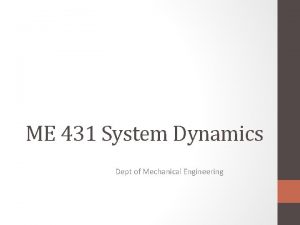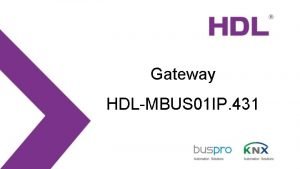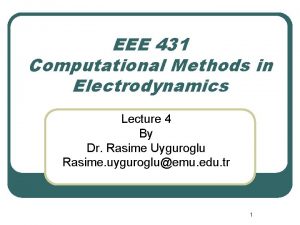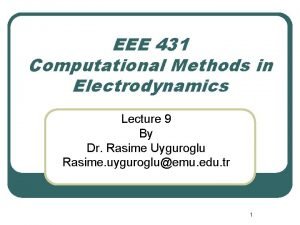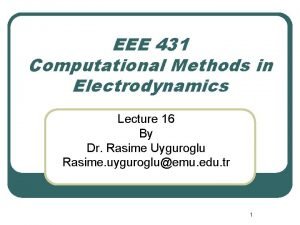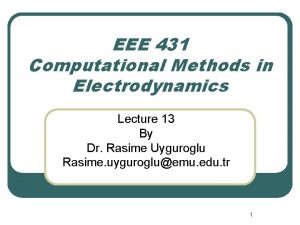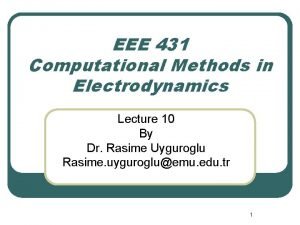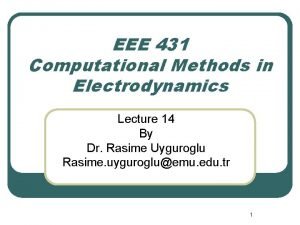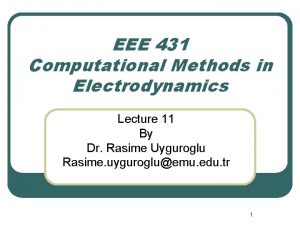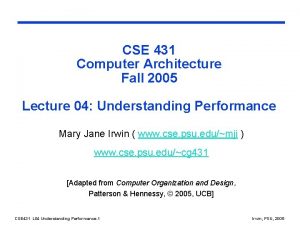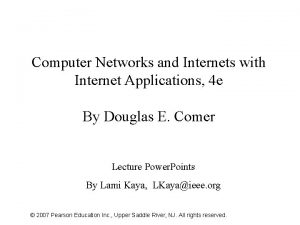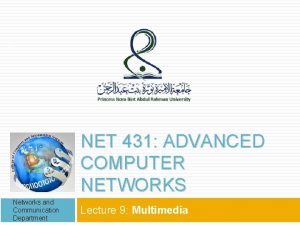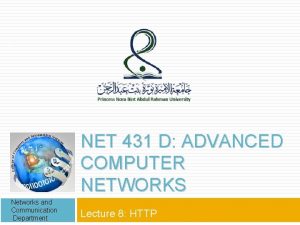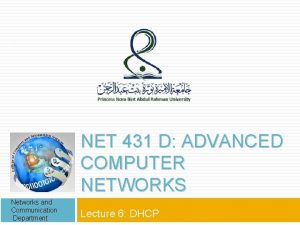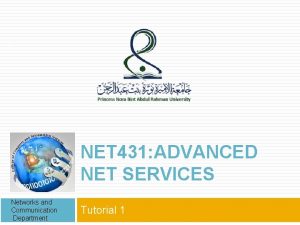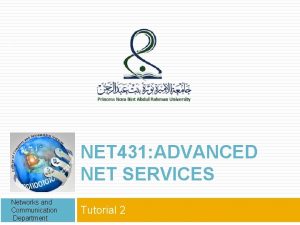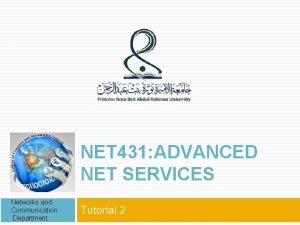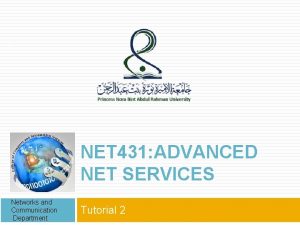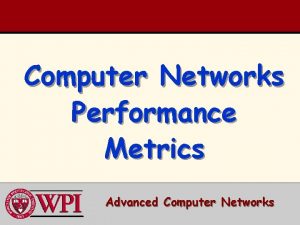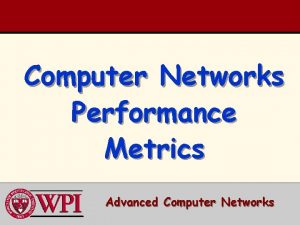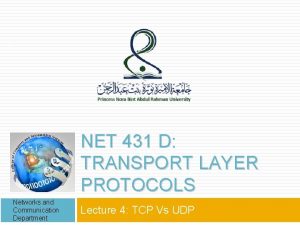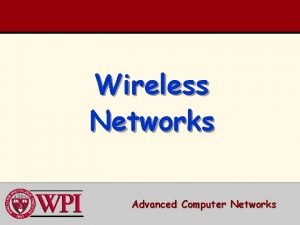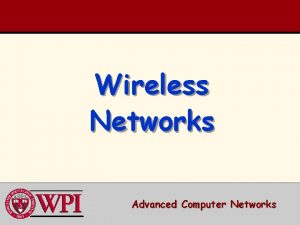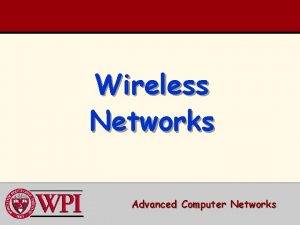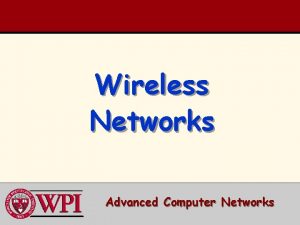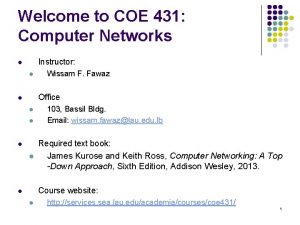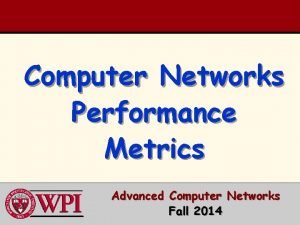1 NET 431 ADVANCED COMPUTER NETWORKS Networks and






































- Slides: 38

1 NET 431: ADVANCED COMPUTER NETWORKS Networks and Communication Department Lecture 1: Introduction

2 By the end of this course, the students should be able to Review of background material on IP, TCP, UDP, Routing. Provide the students insight of fundamental knowledge used in traditional networks services (DNS, HTTP, DHCP). Study the advanced networks multimedia services Study the advanced networks real time services. Outline some advanced networks mobility services. 29 -Oct-20 Networks and Communication Department

3 Revision on Network Models 29 -Oct-20 Networks and Communication Department

The OSI Model An ISO standard that covers all aspects of network communications is the Open Systems Interconnection (OSI) model. An open system is a set of protocol that allows any two different systems to communicate regardless of their underlying architecture (H/W and S/W). ISO is the organization. OSI is the model. 2. 4

The OSI Model The OSI model is a layered framework for the design of network systems that allows for communication between all types of computer systems. It consists of seven separate but related layers, each of which defines a part of the process of moving information across a network. 2. 5

Seven layers of the OSI model 2. 6

An exchange of Data using the OSI model Organization of the Layers 2. 7

Network layer The network layer is responsible for the delivery of individual packets from the source host to the destination host. 2. 8

Network layer Again, the network layer is responsible for the delivery of individual packets from source to destination. If two systems are connected to the same link, there is usually no need for a network layer. If the two systems are attached to different networks with connecting devices between the networks, there is often a need for the network layer to accomplish source-to-destination delivery. 2. 9

Source-to-destination delivery 2. 10

Network layer Other responsibilities of network layer include: �Logical �Routing 2. 11 addressing

Transport layer The transport layer is responsible for the delivery of a message from one process to another. 2. 12

Transport layer Again, the transport layer is responsible for the delivery of a message from one process to another. Unlike the network layer which is source-todestination delivery, the transport layer is process-to-process delivery of the entire message. 2. 13

Reliable process-to-process delivery of a message 2. 14

Transport layer Other responsibilities of transport layer: �Service-point addressing �Segmentation and reassembly �Connection control �Flow control �Error control 2. 15

Figure 2. 15 Summary of layers 2. 16

2 -4 TCP/IP PROTOCOL SUITE • The layers in the TCP/IP protocol suite do not exactly match those in the OSI model. • The original TCP/IP protocol suite was defined as having four layers: host-tonetwork, internet, transport, and application. • When TCP/IP is compared to OSI, we can say that the TCP/IP protocol suite is made of five layers: physical, data link, network, transport, and application. 2. 17

The TCP/IP Architecture and Protocol Suite Copyright © 2010 Pearson Education, Inc. Slide 3 -18

The Layers in the TCP/IP Protocol Suite Source: The TCP/IP Protocol Suite, Behrouz A. Forouzan Application Presentation FTP HTTP NFS DNS … Session Transport ICMP Network TCP UDP IGMP IP ARP RARP Data link Physical 19 Figure of TCP/IP and OSI model

2 -4 TCP/IP PROTOCOL SUITE Network layer (internetwork layer) �TCP/IP at this layer supports the Internetworking Protocol (IP) �There also some other protocols that support data movement in this layer. Including: ARP, RARP, ICMP, and IGMP. 2. 20

Protocols at The Network Layer Internetworking Protocol (IP) Ø Most important protocol of the TCP/IP network stack! Ø Implements internetworking. Ø IP is an unreliable and connectionless protocol- a best-effort delivery. Ø It is host-to-host protocol. 2. 21

Protocols at The Network Layer Address Resolution Protocol (ARP) Ø It is used to find the physical address (NIC) of the node after its Network address is known. Reverse Address Resolution Protocol (RARP) Ø It is used to find the Internet address of the node after its physical address is known. 2. 22

Protocols at The Network Layer Internet Control Message Protocol (ICMP) Ø It is used by hosts and gateways to send notification of datagrams ( packets) problem back to the sender. Internet Group Message Protocol (IGMP) Ø It is used to facilitate the simultaneous transmission of messages to a group of recipients. 2. 23

2 -4 TCP/IP PROTOCOL SUITE Transport Layer �In this layer, the protocol is responsible for delivery of message from a process to another process. 2. 24

Protocols at The Transport Layer Ø User Datagram Protocol (UDP) It adds port addresses, checksum error control, and length information to the data from the upper layer, connectionless unreliable. Transmission Control Protocol (TCP) Ø It is reliable and connection-oriented. 2. 25

Protocols at The Transport Layer Ø Ø Stream Control Transmission Protocol (STCP) It supports the newer application e. g. voice over the Internet. It combine best features of UDP and TCP. 2. 26

2 -5 ADDRESSING Four levels of addresses are used in an internet employing the TCP/IP protocols: • physical (Data link ) addresses , • logical (IP) addresses, • port addresses, and • specific addresses. 2. 27

Figure 2. 18 Relationship of layers and addresses in TCP/IP 2. 28

2 -5 ADDRESSING Physical Addresses �It is knwon as link address. �It is the address of a node as defined by its LAN or WAN. �The size and format of the address depends on the network. Ethernet uses 6 -bytes (48 -bits) NIC Local. Talk (Apple) uses 1 -byte dynamic address 2. 29

Figure 2. 19 Physical addresses 2. 30

2 -5 ADDRESSING Logical Addresses �Necessary for universal communications that are independent of underlying physical networks. �Physical address is not enough in an internetwork environment where the different network can have different address formats. �A logical address in the Internet is 32 -bits. �No two hosts on the Internet have the same IP address. 2. 31

Figure 2. 20 IP addresses 2. 32

Note • The physical addresses will change from hop to hop, but the logical addresses usually remain the same. • No two hosts on the Internet have the same IP address. 2. 33

2 -5 ADDRESSING Port Addresses �It is necessary for the receiver device that runs multiple process to receive data simultaneously this make a need to label each process �A port address is 16 -bits. 2. 34

Figure 2. 21 Port addresses 2. 35

Example 2. 5 As we will see in Chapter 23, a port address is a 16 bit address represented by one decimal number as shown. 753 A 16 -bit port address represented as one single number. 2. 36

Note The physical addresses change from hop to hop, but the logical and port addresses usually remain the same. 2. 37

2 -5 ADDRESSING Specific Addresses � Examples e-mail address URL address �Those addresses get changed to the corresponding port and logical address by the sending computer. 2. 38
 Example of virtual circuit network
Example of virtual circuit network Basestore iptv
Basestore iptv Bio 431
Bio 431 Me 431
Me 431 Hdl buspro setup tool 2
Hdl buspro setup tool 2 Eee 431
Eee 431 Eee 431
Eee 431 Eee 431
Eee 431 Eee 431
Eee 431 Eee 431
Eee 431 Eee 431
Eee 431 Eee 431
Eee 431 Cs 431
Cs 431 431 bce
431 bce Ds 431
Ds 431 Cse 431
Cse 431 Cse 431
Cse 431 431 bc
431 bc Integrated services vs differentiated services
Integrated services vs differentiated services Checksum in computer networks with example
Checksum in computer networks with example Bit stuffing and byte stuffing
Bit stuffing and byte stuffing What is bit and byte stuffing
What is bit and byte stuffing Arp rarp protocol
Arp rarp protocol Analogue and digital transmission in computer networks
Analogue and digital transmission in computer networks Web and http in computer networks
Web and http in computer networks Computer networks and internets with internet applications
Computer networks and internets with internet applications Transmission error in computer networks
Transmission error in computer networks Protocols and standards in computer networks
Protocols and standards in computer networks Error correction in computer networks
Error correction in computer networks Computer networks and internets
Computer networks and internets Ec 6009
Ec 6009 Advanced topics in computer science
Advanced topics in computer science Craig reinhart
Craig reinhart Advanced computer forensics
Advanced computer forensics Advanced computer forensics
Advanced computer forensics Crc in computer networks
Crc in computer networks Crc in computer networks
Crc in computer networks Traffic management in computer networks
Traffic management in computer networks Tanenbaum
Tanenbaum



